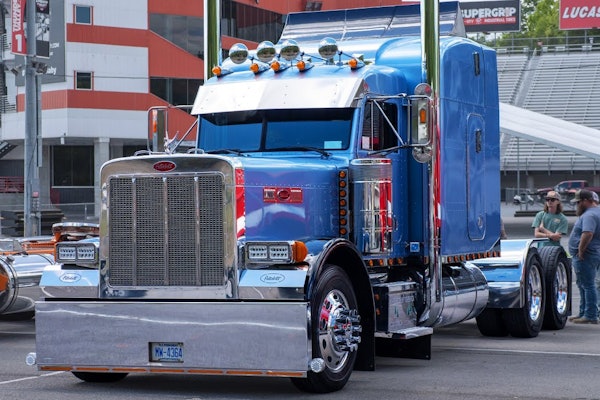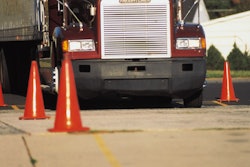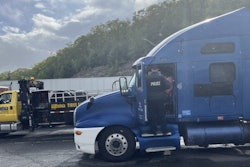Kin Kincaid, a driver for Coal City Cob Co. of Avalon, Texas, checks the connection for a heat transit line that pumps a water-based solution through his tanker to keep volatile concentrated paint between 150 degrees and 190 degrees.
Does a job with high rates and lots of home time sound good? How about a job that’s expensive to enter and loaded with governmental scrutiny?
Hauling a tanker often involves all of that, which can make it undesirable to new owner-operators. The tanker industry attracts experienced owner-operators who are looking for higher rates, stability and home time, says Don Benoit, vice president of operations for Quality Distribution, a major tanker carrier in Tampa, Fla. “We have 2,000 owner-operators making between $1.04 and $1.07 per mile,” Benoit says. “They make as much in a year as the owner-operator pulling a dry van, but run 50,000 to 60,000 miles less.”
Owner-operator Leo Greenwood, who has been pulling tankers for Schneider National for three years, says he never misses home time, thanks to cooperation from Schneider dispatch. “I was home every week,” Greenwood says of 2002. “And I don’t get dirty. I just hook up my hoses and wait.” He seldom pulls the same tanker for more than one load. Greenwood, who drives a 2000 Kenworth T600 with a 460-hp Cummins, says he averages $1.05 per mile for all miles. Last year he grossed $144,000 and netted $68,000.

Most owner-operators who want to pull a tanker lease to a for-hire carrier. According to the Overdrive 2003 Owner-Operator Behavior Report, 9 percent of leased owner-operators pull liquid tankers, but only 2 percent of for-hire owner-operators with their own authority pull liquid tankers. One reason independent owner-operators don’t get their own equipment is cost. New tankers range from $75,000 to $95,000.
Even without buying a tanker, the start-up costs “scare off a lot of owner-operators,” says John Hazenfield of Manfredi Tanker Lines in Newberry, Ohio. The main cost to the owner-operator is usually the pump and compressor, commonly called the blower, which must be mounted on the power unit. The blower can cost $5,000 to $8,000, counting installation. “This is one reason only 2 or 3 percent of our trucks are contractor units,” Hazenfield says.
The National Tanker Truck Association, which represents the biggest carriers, has about 180 members. All members work in the for-hire segment and carry about 90 percent of the nation’s chemicals and 50 percent of the petroleum products. Dry bulk, such as plastic pellets, is also a part of the product mix. At the other end of that scale are the small, mostly private carriers, such as oil jobbers who move petroleum products locally and regionally.
Tanker work tends to be lower mileage. “Seventy percent of our freight is dedicated short-haul work,” says Benoit. “Our average length of haul is only 300 miles.” He says dedicated short-haul drivers pull one to three loads per day. “Some drivers are home every night, in particular those who haul gasoline or products from a rail or barge,” he says. On the other hand, Quality Distribution has a 103-terminal system. “Trucks that run long may be out a week or two,” says Benoit, “But this is only 20 to 30 percent of our business.”
To a great extent, length of haul and percentage of deadhead is determined by the type of product being transported. Gasoline is almost always a day haul with no backhaul, while some food products, such as orange juice, and specialty chemicals can travel coast to coast and often get a backhaul. Long-haul trucks have fewer deadhead miles than regional or day operations.
Loaded miles in the long-haul operation account for 75 percent to 85 percent, Benoit says. Often a product like a strong acid or a poisonous chemical must be moved in a dedicated truck because the tanker cannot subsequently be used to transport any other product. In this case, deadhead miles could be part of the rate paid by the customer.
“Plenty of drivers don’t like the idea of handling chemicals,” Hazenfield says. “But our operation is set up to give our drivers plenty of miles. They can run dedicated long-haul if they want.” Hazenfield notes that most long-haul runs are quick turns of food-grade products or specialty chemicals. “If we don’t find a backhaul right away, we will deadhead the truck back and look for a load along the way,” he says. “The traces of the majority of specialty chemicals we haul can be washed out, but you do have to be careful what you put in the tanker after the wash. Food grade is an easy wash. If you find a load of the same product you may not even have to wash.”
Despite the restrictions that sometimes keep a driver from reloading, Manfredi’s rate of loaded miles is 60 percent to 65 percent. Hazenfield says the deadhead rate depends on how the load was sold to the customer, but is generally not much below the loaded rate.
Wayne Transports of Rosemont, Minn., tries to arrange triangular routes for contractors in its food division, which runs 48 states and Canada. Safety Director Jerry Jarvis says backhauls are sometimes dictated by the availability of washes as much as by the availability of freight. Unlike Quality Distribution or Manfredi, Wayne’s triangular routes keep drivers out as long as two weeks.
Owner-operator Wes Siegerssman, who is paid 70 percent of the revenue, says he has grossed about a dollar a mile, including deadhead, in each of the 11 years he has been with Wayne Transports. “Last year I grossed $119,000 and netted $68,000,” he says. The $68,000 earned by Siegersman and Greenwood is well above normal. The average income in for-hire liquid tankers operations is $45,700, according to the Overdrive 2003 Owner-Operator Behavior Report.
“I am home every week partly because I don’t sit between loads,” says Siegersman, who runs a 1999 W900L with a Cummins ISX 565. Since Wayne has established routes with washes in strategic spots, Siegersman’s able to run more miles than the typical tanker contractor. “I might have to sit a couple of hours waiting at a wash, but that’s about all the dead time I’ve got,” he says.
Unlike some other tanker carriers, which require up to a $3,000 escrow, Wayne charged Siegersman a minimal escrow when he started. For the pump and compressor, the company charged him for installation only and maintained possession of the add-on equipment.
While liability insurance is paid by companies, deductibles as high as $1,000 are commonly the responsibility of the owner-operator. In most other ways, insurance in the tanker industry closely resembles that in the rest of the trucking industry. The tanker industry has an excellent safety record. Despite this, its insurance rates have doubled in recent years.
In addition to possibly high entry costs, the necessity for extensive training can be another reason some owner-operators stay away from hauling bulk commodities. Quality Distribution requires a full seven-day training course. Drivers are trained in commodities from thin solvents to acids, giving the average driver all the skills necessary to handle the majority of loads. Drivers who haul the products in dedicated operations are trained specifically for those products.
Contractors pulling tankers receive more roadside scrutiny from inspectors, but it is the carrier who assumes most of the costs of running a legal and safe operation. The contractor’s responsibility is to follow procedures set out by the company and the U.S. Department of Transportation. Doing so protects the contractor as much as possible from liability, as it does in any operation. The integrity of the tanker is the responsibility of the carrier, another reason major insurance responsibilities do not fall to the owner-operator.
One unique safety aspect of the tanker industry is shifting of loads. Food-grade products and specialty chemicals, in particular, are prone to surge because the so-called shotgun or smooth-bore tankers used for hauling these products do not have compartments or baffles, surge-limiting devices more commonly found in petroleum tankers. Smooth shifting, limiting shifts, keeping the load against the front bulkhead as much as possible, maintaining long following distances and pre-emptive braking are techniques the tanker driver must use constantly.
Unloading is another significant difference between bulk hauling and other types of trucking. Delivery schedules are strict. Customers commonly give only a 30-minute window plus or minus 15 minutes, helping keep their operations safe. Unloading takes 45 minutes to three hours, depending on the product.
The tanker industry can offer a stability of compensation, working conditions and scheduling not often found in other trucking segments. But those advantages are the product of a typically steep entry price in terms of initial investment and training. As in all of trucking, the company you choose will have a great deal to do with your lifestyle and your day-to-day operation.
ENDANGERED SPECIES: HAZMAT HAULERS
In the wake of Sept. 11, 2001, hazmat hauling, a major part of the tanker business, isn’t what it used to be.
On May 2, the Transportation Security Administration issued an interim final rule that toughened security standards for holders of commercial driver’s license hazmat endorsements.
Carriers and states have complained about inadequate time or guidance regarding implementation of the rule’s provisions for background checks on hazmat-qualified drivers, including fingerprint checks, that were to be complete by Nov. 3. However, in mid-September, the American Association of Motor Vehicle Administrators website posted a bulletin saying the organization had been notified by TSA of plans to provide “a generous extension” of the deadline. Spokespersons for TSA, which is doing the checks with the states and the Department of Justice, would not confirm those plans.
The new security rules call for hazmat holders to be U.S. citizens or lawful permanent residents and have no disqualifying criminal offenses. They also must not have been ruled mentally incompetent. Hazmat holders who don’t meet security standards had a Sept. 2 deadline to surrender their endorsement, though not many did so. “If they are pulled over after that, they could lose their hazmat endorsements, and it could impact their CDL,” says TSA spokesperson Brian Turmail.
Industry officials say the new screenings could change the economics of hazmat hauling. At Quality Distribution, “We have already seen a loss of drivers who have moved to carriers who do not handle hazmat,” says Vice President Don Benoit.
“New regulations will shrink the driver pool, giving drivers more clout,” says Mark Ritz, safety director at Manfredi Tanker Lines. “Some drivers are going to try to leverage this situation into a bigger paycheck.”
“Drivers have a legitimate claim to more compensation if they have more credentials,” says John Conley, vice president of National Tanker Truck Carriers. On the other hand, “The tanker industry will respond the way our shippers allow us to respond,” he says, which could mean rates remain stagnant. This would force carriers to come up with creative ways to maintain their hazmat work force.
Conley says he has talked to hazmat tanker carriers willing to pick up fees for stringent new background checks. “But,” he says, “there are some who will simply pass it along to the drivers and hope for the best.”
An aging driver pool, combined with the potential loss of drivers no longer qualified to haul hazmat and others who decide to haul non-hazmat goods rather than incur fees for background checks, will put hazmat carriers in a difficult position, Conley says. “The government has got to do something,” he says.
Some fleets also will face tough choices regarding the driver who is denied a hazmat endorsement renewal. “Do you fire the guy or do you take the chance and let him pull non-hazardous, hoping that in the heat of dispatch he isn’t given a hazmat load?” Ritz asks. “You have a situation developing where the bad guys will be driving school buses and milk trucks.”











